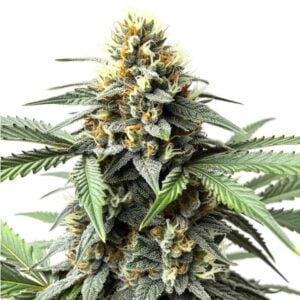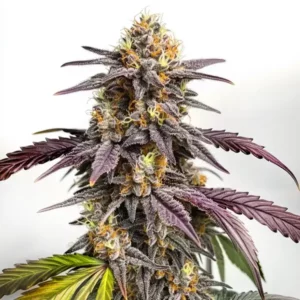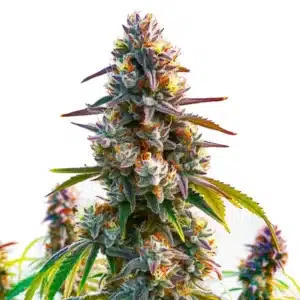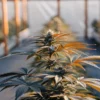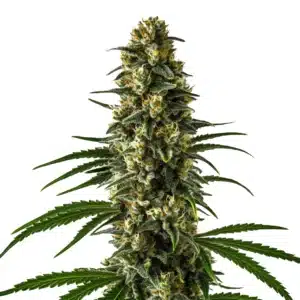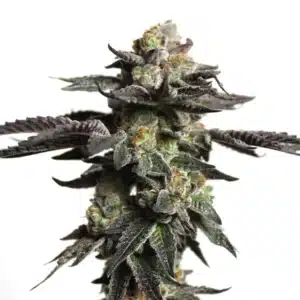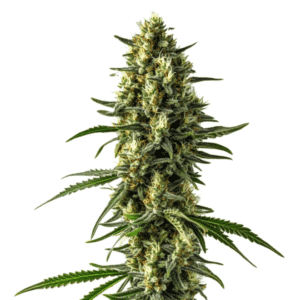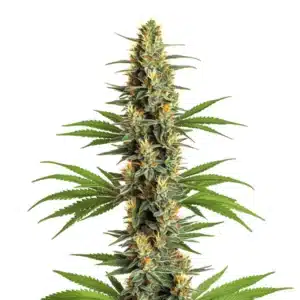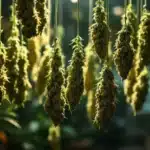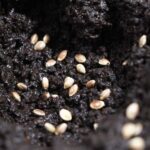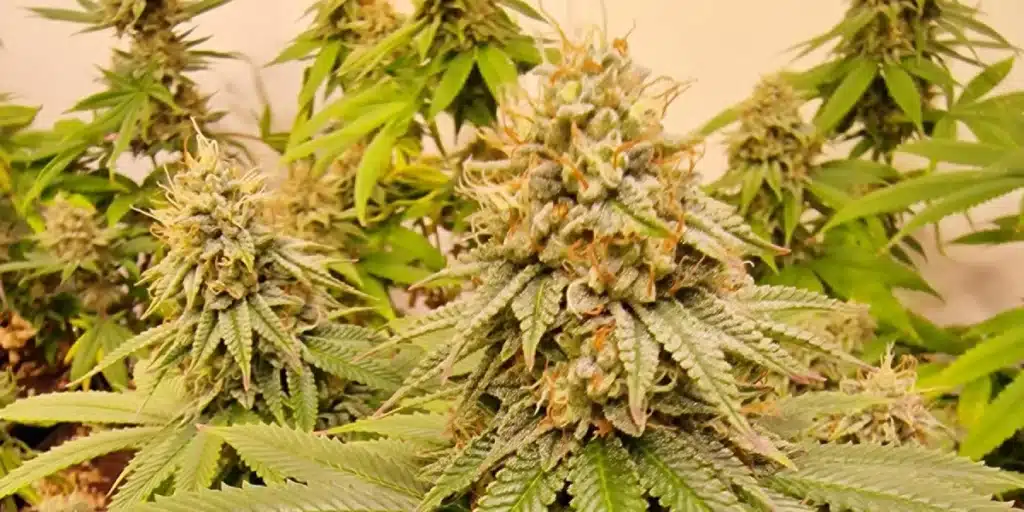
How To Grow Apples And Bananas Strain
Apples And Bananas Strain Cannabis Seed Description
The Apple and Bananas cannabis strain is generally considered a balanced hybrid with both indica and sativa genetics, though some users still wonder, “Is the apple and banana strain indica or sativa?” In reality, it leans slightly indica according to several reports, while others describe it as more evenly balanced. This strain is a cross of Platinum Cookies, Granddaddy Purple and Gelatti, creating a unique profile known for delivering both relaxing and uplifting effects.
Growing the Apples and Bananas strain is a rewarding experience, especially for intermediate cultivators. This hybrid adapts well to both indoor and outdoor setups, particularly in warm and sunny climates. While it’s generally considered easy to manage, growers should be prepared to apply basic training techniques to control its structure and enhance yield potential. Indoors, the Apples and Bananas strain typically flowers in 7 to 10 weeks, while outdoor plants are usually ready for harvest by late September to early October.
Recommended Strains
Apples and Bananas
|
|
THC | 23% - 30% (High) |
|
|
Type | Feminized |
|
|
Yield | Low |
|
|
Phenotype | 50% Indica / 50% Sativa |
Do-Si-Dos Autoflower
|
|
THC | 18% - 20% (Medium) |
|
|
Type | Autoflowering |
|
|
Yield | High |
|
|
Phenotype | 20% Indica / 80% Sativa |
Apple And Banana Strain is a highly sought-after cannabis strain known for its exceptional qualities. It is revered by cannabis enthusiasts for its distinctive aroma, flavor, and effects, making it a top choice for both recreational and medicinal users.
This Strain is the result of a carefully crafted genetic combination, resulting in a hybrid that perfectly balances Indica and Sativa traits. Its buds are typically dense and visually appealing, showcasing a rich palette of colors, including shades of green, orange, and purple. These buds are generously coated with resin, giving them a glistening appearance.
What sets Apples And Bananas Strain apart, often known as the apples & bananas strain, is its complex and delightful aroma and flavor profile It offers a harmonious blend of fruity and tropical notes, with hints of apples and banana, hence the name. This unique combination provides an unforgettable sensory experience for cannabis connoisseurs.
Promos & Deals
Environmental Requirements for Growing Marijuana Apples And Bananas
Creating the perfect environment for your Apples And Bananas Strain plants is essential to ensure their successful growth and development. The specific environmental needs of this strain is key to achieving optimal results.
This Strain thrives in a temperate climate with daytime temperatures ranging from 70-80°F (21-27°C) and slightly cooler nights. Maintaining a stable temperature and humidity level within your grow space is crucial to prevent stress and potential issues such as mold or mildew.
When cultivating Apples And Bananas Strain indoors, it’s essential to provide adequate lighting. High-quality LED grow lights or HPS lamps are recommended to support photosynthesis and robust bud formation. During the vegetative phase, maintain a light cycle of 18-20 hours of light per day, then switch to 12 hours of light and 12 hours of uninterrupted darkness to initiate flowering.
For outdoor cultivation, select a location with abundant sunlight and favorable climate conditions. Apples And Bananas Strain thrives in sunny and warm environments, allowing it to reach its full potential. If you’re in a region with cooler climates, consider using a greenhouse or providing additional protection to extend the growing season and safeguard your plants from adverse weather conditions. For additional apples and bananas strain grow info, our guide details the optimal environmental conditions needed for successful cultivation.
Setting Up The Growing Cannabis Space
Before embarking on your Apples And Bananas Strain cultivation journey, it’s crucial to establish an efficient and well-organized growing space. Whether you choose indoor or outdoor cultivation, the following factors should be considered:
Indoor Cannabis Cultivation
For indoor growers, selecting the right grow tent or dedicated grow room is paramount. Ensure that the space provides enough vertical room for your plants to flourish and has proper ventilation for fresh airflow. Install an efficient exhaust system with a carbon filter to control odors and prevent heat or humidity buildup. Use reflective materials or Mylar sheets to maximize light distribution and prevent light leaks that could disrupt the flowering phase.
Choose a suitable growing medium for this Strain, such as high-quality soil or a hydroponic system, depending on your preferences and experience. Ensure proper drainage to prevent overwatering and maintain a balanced pH level of approximately 6.0-6.5 for optimal nutrient absorption.
Outdoor Cannabis Cultivation
When cultivating Apples And Bananas Strain outdoors, select a location with ample sunlight and suitable soil conditions. Ensure that the soil is well-draining and rich in organic matter. Consider using large containers or fabric pots to have better control over soil quality and root health. Additionally, protect your plants from strong winds by placing them near a fence or using windbreaks.
Using stakes or trellises to support the branches of your Apple And Banana Strain plants is advisable. This helps prevent branches from bending or breaking under the weight of dense buds and promotes better airflow.
Propagation and Germination of Marijuana Apples And Bananas Seeds
Successful germination and propagation are essential for healthy and robust Apples And Bananas Strain plants. Follow these steps to ensure a high germination rate and successful propagation:
- Start by selecting high-quality feminized apples and bananas strain seeds from a reputable seed bank This ensures genetic stability and feminization of your plants.
- Initiate the germination process by soaking the seeds in distilled water or a damp paper towel for 24-48 hours. Maintain a temperature between 70-85°F (21-29°C) and provide a dark, undisturbed environment.
- After the seeds have soaked and developed taproots, transfer them carefully to a pre-moistened growing medium, such as a seedling tray or small pots filled with a light and well-draining soil mix.
- Place the seeds in a warm and humid environment with gentle airflow. Maintain a temperature around 75-80°F (24-27°C) and a humidity level of 60-70% for optimal germination.
- Provide indirect light to the seedlings during the first few days, gradually increasing the light intensity as they develop. Avoid exposing them to intense light or heat that could cause stress or damage.
- Once the seedlings have grown a few sets of true leaves, they are ready to be transplanted into larger pots or the final growing containers.
By following these germination and propagation steps, you can ensure a strong start for your Apple And Banana Strain plants and establish a solid foundation for healthy growth and abundant yields.
Vegetative Phase of Cannabis seeds Apple And Banana Strain
The vegetative phase plays a pivotal role in the development of your Apples And Bananas Strain plants. Here are key considerations during this phase:
Lighting: Provide your Apple And Banana Strain plants with 18-20 hours of light per day to promote vigorous vegetative growth. High-quality LED grow lights or HPS lamps are recommended to ensure sufficient light intensity and spectral distribution.
Nutrition: During the vegetative phase, your Apples And Bananas Strain plants require a balanced and nutrient-rich diet. Use a reputable cannabis fertilizer with a higher nitrogen (N) content to encourage healthy leaf and stem growth. Follow the manufacturer’s instructions and monitor the plants for any signs of nutrient deficiencies or excesses.
Watering: Water your plants when the top inch of the soil feels dry. Avoid overwatering, as it can lead to root rot and other moisture-related issues. Allow the soil to dry out slightly between watering sessions, but ensure the plants do not experience extreme drought.
Training: Consider using training techniques such as low-stress training (LST) or topping to control the height and shape of your Apples And Bananas Strain plants. These methods help create an even canopy, increase light penetration, and promote better bud development.
Pruning: Remove any lower branches or leaves that receive little light or show signs of disease or pests. This helps improve airflow and reduces the risk of mold or mildew formation.
By providing your Apple And Banana Strain plants with the right environmental conditions, nutrition, and care during the vegetative phase, you can establish healthy and robust plants ready for the flowering stage.
Flowering Phase of Marijuana Seeds Apples And Bananas Strain
The flowering phase is the most anticipated stage in growing Apples And Bananas Strain, as it is when the plants develop their characteristic buds. Here’s what you need to know:
Lighting: Adjust the light cycle to 12 hours of light and 12 hours of uninterrupted darkness to initiate the flowering phase. Use a timer to maintain a consistent light schedule. During this stage, your Apple And Banana Strain plants require intense light, so ensure your grow lights provide adequate coverage and maintain the appropriate distance from the canopy.
Nutrition: Transition from a nutrient formula higher in nitrogen to a bloom or flowering-specific nutrient formula. These formulations are generally higher in phosphorus (P) and potassium (K), which promote bud development and overall flowering performance. Monitor the plants closely and adjust nutrient levels as needed to avoid deficiencies or toxicities.
Temperature and Humidity: Maintain a slightly lower temperature during the flowering phase, ideally around 65-75°F (18-24°C), to encourage resin production and prevent heat-related stress. As for humidity, aim for levels around 40-50% to minimize the risk of mold or bud rot.
Support: As your Apple And Banana Strain plants enter the flowering phase, the weight of the developing buds may cause branches to bend or break. Provide adequate support using stakes or trellises to ensure the plants can bear the weight and avoid bud damage.
Flowering Time: Apples And Bananas Strain typically has a flowering time of 8-10 weeks. For growers looking for specific apples and bananas flowering time insights, it’s important to monitor trichome development closely with a magnifying tool. Monitor trichome development using a magnifying tool to determine the optimal harvest window.
Throughout the flowering phase, maintain a vigilant eye for any signs of pests or diseases. Implement proper pest management practices and take immediate action at the first sight of infestation or abnormalities.
Cannabis Fertilization and Nutrition – Apples And Bananas Strain
Proper nutrition and fertilization are crucial for maximizing the growth, yield, and overall health of your Apples And Bananas Strain plants. Consider the following tips:
Choosing the Right Fertilizer: Select a high-quality cannabis-specific fertilizer or nutrient line that provides a balanced blend of macro and micronutrients. Look for products rich in nitrogen (N), phosphorus (P), and potassium (K) to support healthy growth, root development, and bud formation.
Feeding Schedule: Follow the manufacturer’s instructions and adjust the feeding schedule based on your plants’ specific needs. Start with a lower concentration and gradually increase it as the plants progress through their growth stages. Monitor the plants closely for any signs of nutrient deficiencies or excesses, and make adjustments accordingly.
Supplements and Additives: Consider incorporating supplements and additives into your feeding regimen to enhance specific aspects of plant development. These may include bloom boosters, beneficial microbes, enzymes, or organic amendments that improve soil structure and nutrient availability.
Regularly monitor your plants’ response to the feeding program, adjusting nutrient concentrations and frequencies as needed. Remember to flush the plants with pure water during the final weeks of the flowering phase to remove any excess salts or nutrients, which can affect the flavor and overall quality of the final harvest.
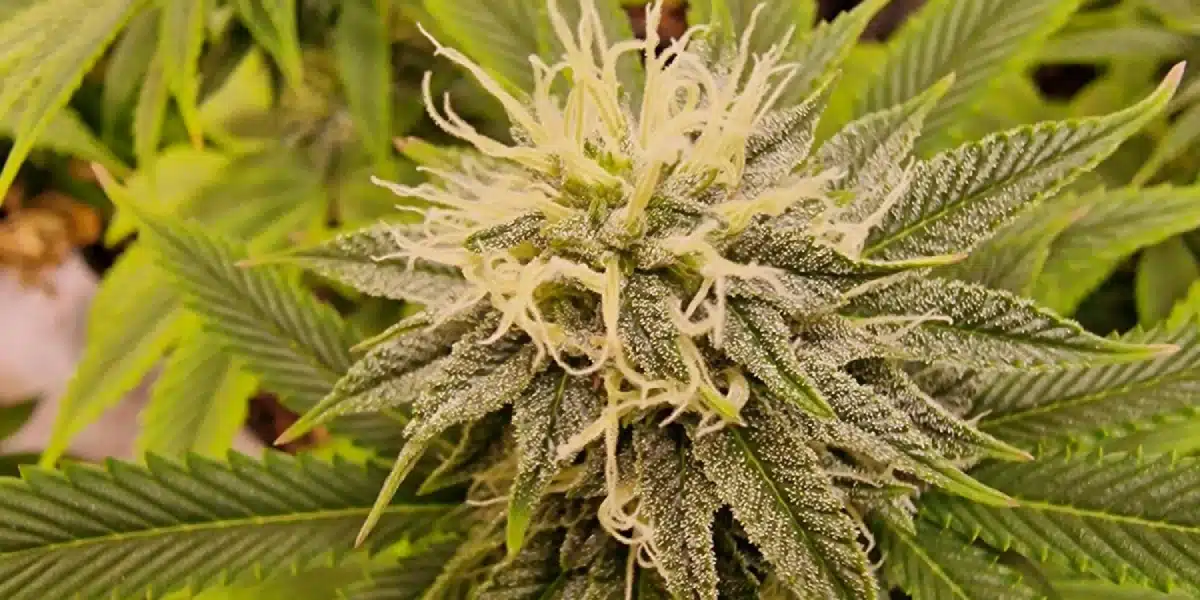
Pest And Disease Control for Cannabis Growing – Apples And Bananas Strain
While Apple And Banana Strain is known for its resilience, it is still susceptible to pests and diseases. Implementing proper pest and disease control measures is crucial to protect your plants and ensure a successful cultivation. Here are some preventive and corrective actions:
Prevention:
- Regularly inspect your plants for any signs of pests, such as spider mites, aphids, or thrips. Early detection is key to preventing a full-blown infestation.
- Maintain a clean and tidy growing space, removing any dead plant material or debris that could harbor pests or pathogens.
- Introduce beneficial insects, such as ladybugs or predatory mites, to your garden to help control pests naturally.
- Ensure proper airflow and ventilation in the growing space to reduce the risk of mold or mildew formation.
- Quarantine new plants or clones before introducing them into your growing area to prevent the spread of pests or diseases.
Corrective Actions:
- If you detect pests, use organic or low-toxicity pest control products specifically formulated to treat the identified pests. Be cautious with chemical pesticides, as they can leave residues on your buds and harm the environment.
- For common cannabis pests like spider mites, consider using neem oil, insecticidal soap, or diatomaceous earth as natural and effective control methods.
- If you encounter fungal diseases such as powdery mildew or bud rot, take immediate action. Prune affected plant parts, increase airflow, and consider using organic fungicides like potassium bicarbonate or sulfur to manage the issue.
- Practice proper sanitation by sterilizing your gardening tools and equipment to prevent the spread of diseases.
Harvesting and Curing for Cannabis Growing – Apples And Bananas Strain
The harvesting and curing process is a critical step in producing high-quality Apples And Bananas Strain buds with the best aroma, flavor, and potency. Here’s how to do it right:
Harvesting:
- Monitor the trichomes on your Apple And Banana Strain buds using a magnifying tool. Harvest when most trichomes have turned cloudy or milky, with some amber trichomes for a more relaxing effect.
- Use sharp, clean scissors or pruning shears to carefully trim the mature buds from the plant. Be gentle to avoid damaging the trichomes and delicate bud structure.
- Hang the harvested branches upside down in a dark, cool, and well-ventilated space. Maintain a temperature of 60-70°F (15-21°C) and a humidity level of 45-55% during the drying process.
- Drying typically takes 7-14 days, depending on environmental conditions and bud size. Buds are ready for the next stage when they feel dry to the touch but still have some moisture inside.
Curing:
- After drying, carefully trim the buds from the branches and place them in glass jars with airtight lids.
- Store the jars in a cool, dark place with a consistent temperature of around 60-70°F (15-21°C).
- During the curing process, open the jars daily for a few minutes to release any excess moisture and promote even curing. After a week or two, you can reduce the frequency of jar opening to once a week.
- Curing improves the flavor, aroma, and smoothness of your Apples And Bananas Strain buds. It can last for several weeks to several months, depending on your preferences.
Properly dried and cured Apple And Bananas Strain buds will provide a more enjoyable and potent cannabis experience. The patience and care you invest in this process will be rewarded with exceptional quality cannabis.
Apples And Bananas Strain: Indica or Sativa?
Apple And Banana Strain is considered a hybrid strain, which means it combines characteristics of both Indica and Sativa varieties. The specific balance between these two types can vary depending on the breeder’s genetics and the plant’s phenotype.
Typically, hybrid strains like Apples And Bananas Strain aim to provide a well-rounded experience, offering the best of both worlds. Indica traits may include relaxation, body effects, and pain relief, while Sativa traits can bring energy, creativity, and cerebral effects.
To determine the exact Indica-to-Sativa ratio and the effects of the particular Apple And Banana Strain you’re growing, it’s advisable to refer to the breeder’s information or conduct research on the specific strain you have. Keep in mind that individual experiences may vary based on factors such as genetics, growing conditions, and personal tolerance.
Advantages of Growing Apples And Bananas Seeds
There are several advantages to growing Apple And Banana Strain cannabis seeds, which make it a popular choice among cultivators:
- Unique Aroma and Flavor: Apples And Bananas Strain is known for its distinctive and delightful aroma and flavor profile, offering a blend of fruity and tropical notes with hints of apples and banana.
- Hybrid Effects: Being a hybrid strain, Apples And Bananas Strain provides a balanced experience, combining the relaxing and pain-relieving qualities of Indica with the energizing and creative effects of Sativa.
- High Demand: Apple And Banana Strain is highly sought after by both recreational and medicinal users, making it a potentially lucrative choice for growers.
- Resilience: Apple And Bananas Strain is known for its resilience, making it suitable for growers with varying levels of experience.
- Beautiful Buds: The visual appeal of Apple And Banana Strain buds, with their rich colors and generous resin coating, adds to the overall satisfaction of cultivation.
These advantages make Apples And Bananas Strain a rewarding strain to grow, whether you’re a novice or experienced cannabis cultivator.
Disadvantages of Growing Apples And Bananas Seeds
While there are numerous advantages to growing Apple And Bananas Strain cannabis seeds, it’s essential to be aware of potential disadvantages as well:
- Legal Restrictions: The cultivation of cannabis may be subject to legal restrictions and regulations in your region or country. Ensure you are in compliance with local laws and regulations before growing Apple And Bananas Strain.
- Odor Control: Apples And Bananas Strain can have a strong and distinctive odor during flowering. Proper odor control measures may be necessary to prevent unwanted attention.
- Initial Investment: Setting up a suitable indoor grow space or greenhouse can require an initial investment in equipment and lighting.
- Time and Effort: Growing cannabis, including Apples And Bananas Strain, requires time, attention, and effort throughout various growth stages, from germination to harvesting and curing.
- Pest and Disease Risks: Like all cannabis plants, Apple And Banana Strain is susceptible to pests and diseases that can impact the health and yield of your crop.
Addressing these potential disadvantages can help you make informed decisions and ensure a successful cultivation experience.
Why Buy Apples And Bananas Seeds
There are several reasons why you might choose to buy Apples And Bananas Strain marijuana seeds, including the increasing availability of apples and bananas autoflower options for growers seeking a faster, more compact grow cycle:
- Genetic Stability: Purchasing seeds from a reputable seed bank ensures genetic stability and consistency in your crop, allowing you to grow plants with the desired characteristics.
- Strain Selection: Seed banks offer a wide variety of strains, allowing you to choose the specific cannabis strains that align with your preferences and needs.
- Quality Assurance: Reputable seed banks often provide quality assurance, ensuring that the seeds are viable and free from genetic defects or contamination.
- Legal Compliance: Buying seeds from a legitimate source can help ensure you are in compliance with local laws and regulations regarding cannabis cultivation.
- Access to Rare Strains: Seed banks may offer rare or hard-to-find strains like Apple And Banana Strain, allowing you to cultivate unique and sought-after cannabis varieties.
When purchasing Apples And Bananas Strain marijuana seeds or any other cannabis seeds, it’s essential to choose a reputable and trusted seed bank to ensure the quality and authenticity of the seeds you receive.
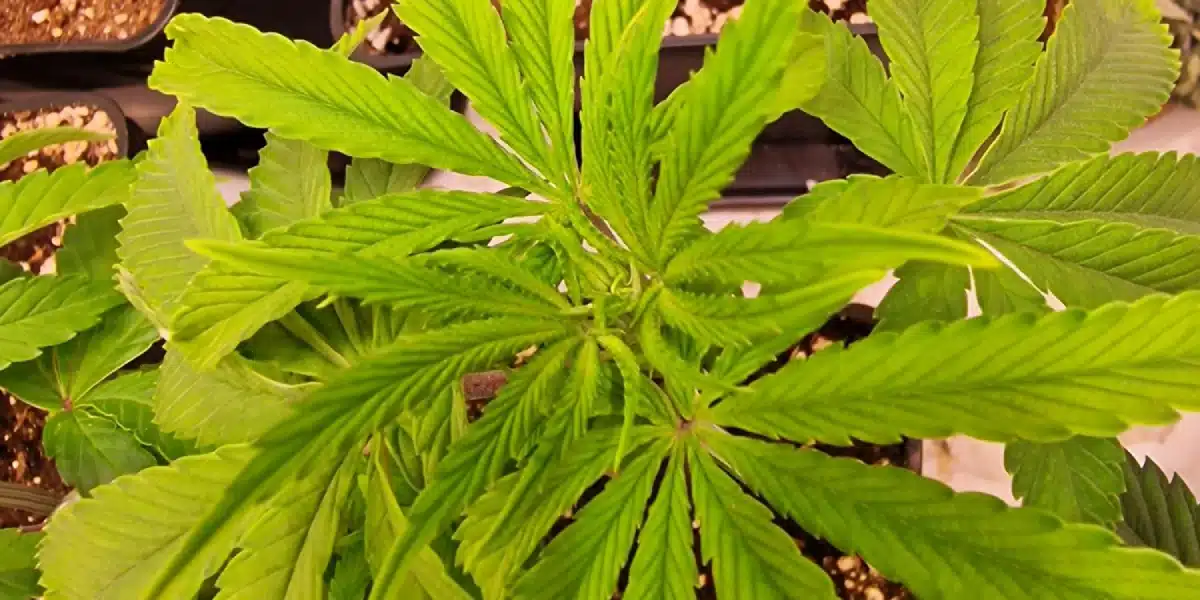
FAQs about Apples and Banana Strain
What are the ideal environmental conditions for growing Apples and Bananas Strain?
Optimal growth for Apples and Bananas Strain is achieved in a temperate climate with daytime temperatures ranging from 70-80°F and slightly cooler nights. Consistent humidity, proper ventilation, and adequate lighting are essential for robust plant development. Indoor setups benefit from high-quality LED or HPS lights, while outdoor growers should ensure abundant sunlight and well-draining soil for maximizing yield and maintaining overall plant health with care.
How do I properly manage the flowering phase for Apples and Bananas Strain?
During the flowering phase, switch to a 12-hour light/dark cycle to promote bud formation. Use a bloom-specific nutrient formula and carefully monitor temperature and humidity. Support heavy branches with stakes or trellises to prevent damage. Regularly inspect for pests and diseases to ensure optimal plant health, resulting in an abundant harvest of evenly matured buds with enhanced resin production, ensuring consistent quality and maximum yield.
What are the common challenges when cultivating Apples and Bananas Strain?
Cultivating Apples and Bananas Strain may present challenges such as managing strong odors, preventing pest infestations, and ensuring proper nutrient balance. Environmental fluctuations, improper lighting, or inadequate ventilation can hinder plant growth. Additionally, legal restrictions and initial setup costs may complicate cultivation. Monitoring plants closely and applying organic pest control methods can mitigate these issues, promoting healthy development and maximizing yield throughout the growing cycle.



